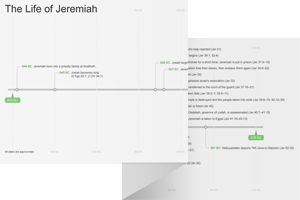24:1–10 Jeremiah reports a vision in which he saw two baskets of figs—one good and one bad—before the temple of Yahweh. The interpretation of the vision looks ahead to Yahweh’s plan to bring His people back from Babylonian exile. Those who remain in the land or flee to Egypt are seen as opposing Yahweh’s plan. The vision is dated to the time after Jehoiachin and the upper class of Judah were taken into exile in Babylon (597 bc). The comparison of the good and bad figs likely is a critique on the poor quality of the leadership left behind in Judah. Jeremiah is generally critical of the bad leadership advice that King Zedekiah received from his inept advisers. |
24:1 figs A sweet, succulent fruit that is common in biblical imagery as a symbol of prosperity and security (see 1 Kgs 4:25; Mic 4:4).
Nebuchadnezzar See note on Jer 21:2.
the officials of Judah, and the craftsmen, and the smiths Compare 2 Kgs 24:12–16. All the experienced and skilled people were taken to Babylon.
24:5 to the land of the Chaldeans Describes exile in Babylon. “Chaldean” and “Babylonian” are generally synonymous in biblical usage (see note on Isa 43:14).
24:6 I will set my eyes on them The oracles of restoration and salvation are directed at the first group of exiles to Babylon, indicating Yahweh’s displeasure with those who have remained in Judah—especially the leaders (Jer 24:8).
24:7 I will give to them a heart Yahweh gives them the ability to obey and follow Him properly. See Deut 30:6; Ezek 11:19; 36:26.
24:8 Zedekiah See note on Jer 21:1. The people who remained were likely rejected because they did not repent after seeing the fate of the first group of exiles in 597 bc.
the remnant of Jerusalem The contrast between the good and bad figs demonstrates the positive and negative functions of the biblical image of the remnant. In 8:3, the remnant that escapes the first round of judgment will still be punished (compare Ezek 6:8 and note; 6:9 and note).
those who live in the land of Egypt Jews likely emigrated to Egypt in response to the Babylonian invasion in 597 bc. Jeremiah is forced to accompany a group fleeing to Egypt after the destruction of Jerusalem in 586 bc (Jer 43–44).
24:10 sword, the famine, and the plague These disasters probably reflect the curses for disobeying the covenant given in Leviticus and Deuteronomy. See note on 14:12.

|
About Faithlife Study BibleFaithlife Study Bible (FSB) is your guide to the ancient world of the Old and New Testaments, with study notes and articles that draw from a wide range of academic research. FSB helps you learn how to think about interpretation methods and issues so that you can gain a deeper understanding of the text. |
| Copyright |
Copyright 2012 Logos Bible Software. |
| Support Info | fsb |
 Loading…
Loading…


 in southern Egypt from the sixth to fourth centuries
in southern Egypt from the sixth to fourth centuries